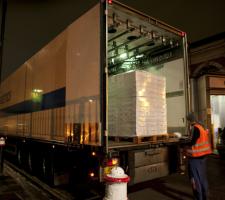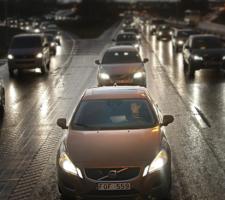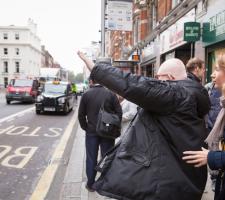
The future of mobility is going to be driven by services.” That’s the opening position of Paul Campion, CEO of the
Campion was previously with
TSC has been involved in several high-profile projects such as autonomous pod trials but most of its work is less headline-grabbing - although equally important - such as tackling urban congestion. In the UK, as elsewhere, the category of road traffic that has increased most over the past 10 years is vans and light goods, as people increasingly order products online for home or office delivery.
It was also involved in a project which looked at medical deliveries to the University Hospital in Southampton (ITS International, November/December 2018). The hospital receives over 850 deliveries a week, adding considerable pressure to the city’s already congested roads. The project identified that a consolidation centre on the outskirts of the UK city could consolidate deliveries down to 25 a week, removing over 3,300 large vehicles from the centre of Southampton every month.
Different legislation
Consolidation is absolutely critical and must be part of the future – the question is: ‘Who makes money?’ Currently there are hundreds of people paid to take goods to and from the hospital and a consolidated delivery would take business away from all but a few of them.
He quotes the UK’s minister for roads, Jesse Norman, saying: “Markets are social constructs. Don’t ask if they are free or not, ask ‘are they doing what we want them to do?’”
Campion adds: “The transport industry is a series of such constructs that arguably are now not doing what they need to do for the future.” His favourite example is the different legislation applied to taxis and private hire. “It is purely a regulatory difference based on technical limitations and in the past, you had to have a vehicle you could hail on the street because you didn’t know where the traveller was or where the taxis were.”
However, he goes on: “
That’s not to suggest Campion is in favour of removing all regulations. He says, “At the Catapult we spend our time thinking about how that sector should and could look and how regulations can be drafted to build markets that will deliver better outcomes given the new technical capabilities.”
This inevitably leads to the subject of the social impact of driverless cars – particularly the impact on jobs (as, globally, transport is a major – if not the biggest - employer of the male workforce).
While accepting that automation could impact the likes of minicab and taxi drivers, he does not believe that overall the impact will be as drastic as it may first appear. The obvious example is driving heavy trucks – a sector where there is a growing shortage of drivers both in the UK and elsewhere: “It isn’t a great job and doesn’t attract the younger generation, so if technology can relieve that pressure it will be a benefit to companies that can’t recruit drivers, and society.”
Customer service
He argues that a lot of jobs are described as driving but many of those entail far more than simply moving goods or people from A to B, and are jobs with a driving requirement - take a delivery driver, for example. “They are really a customer service employee: they have to hand over the correct goods to the right people, get the docket signed, collect the empties and so on,” he says. “Driving is only part of that job so even if the truck drives itself, the ‘driver’ would still have a job.”
Another case in point is a community nurse or care worker who visits sick or elderly people in their own home and needs to drive from one appointment to the next. “These people don’t become a nurse or care worker to drive,” Campion says.
“So if the car could drive itself it would remove a limitation on the pool of people who can be employed in that role. Furthermore, the travelling time could be spent filling out the paperwork or making calls to set up other appointments which would maximise the individual’s efficiency. At the moment, all they can do is drive.”
He also adds that when the nurse or care worker is making their visit, that self-driving car could be used to collect a prescription or get other supplies.
In a meeting with the Unite trade union, which represents many drivers, it became apparent that delivery drivers in London enjoyed the compulsory switch to night-time freight deliveries during the 2012 Olympic Games. The streets were clear and they could get the job done quickly and with the minimum delay and frustration.
He sees night-time deliveries as a perfect opportunity to alleviate congestion. “If the heavy goods vehicles are off the road during the day then 10% of the traffic would disappear but there would be night-time disruption and disturbance to residents, and that is a problem. This is where everything starts to converge: if we have consolidation centres there would be one delivery, not 10, and if we use electric vehicles they are virtually silent.”
Congestion decisions
Using technology, we could confine trucks to certain routes to minimise any disturbance and would also know exactly where each vehicle is at any given time (if somebody complains that they were woken up at night), he argues. “Those living alongside these routes may be charged a lower rate of council tax to compensate for their potentially disturbed sleep,” Campion adds.
Feedback from Londoners was that it was noise from the reversing bleepers, truck-mounted refrigeration units, tail lifts and roller cages that disrupted sleep the most.
“The techniques and technology are already available. We need to shape the market so it is to people’s and companies’ advantage to use the ones we as a society want them to use,” he goes on.
His view on congestion may surprise many: “Congestion is the way we ration access to a resource that is free at the point of delivery.” He explains: “Spending on roads is justified by the amount of time, and therefore money, a new or upgraded road will save.” But, he insists, research says that people would rather take that time-saving and move further out of town where they can afford a bigger house.
“Therefore, the roads are exactly as congested as the drivers’ decisions about how much wasted time they are willing to tolerate and that’s why you can never build your way out of congestion,” Campion says. “Statistics show that most people are prepared to commute [using one or a combination of modes] for about one hour a day. If the people in driverless vehicles can spend commuting time doing useful work, they might not worry if the journey time is longer and congestion could get worse. In that case, the drivers of normal vehicles will have to recalculate if they are prepared to sit it out or if they find a different way to travel. That’s the market giving us exactly what we have designed it to provide.”
Added supercomputers
However, he does not expect autonomous vehicles (AVs) to form a significant proportion of the vehicle fleet any time soon, pointing out that the average age of cars being scrapped is almost 14 years and AVs will be very expensive because they are “a normal, dumb car with a supercomputer added”. Campion also draws a parallel with electric cars which have, so far, failed to take even a double-digit percentage of the UK’s new car market.
In terms of reducing congestion and emissions, the load factor – the average number of people in a vehicle, particularly each car - is far more significant. “If we could get that up from 1.2 to 1.5, we wouldn’t need to build another urban road for 20 or 30 years,” he says but adds the caveat that getting strangers to share a car will not be easy. “I’ve always said in the UK it is illegal to talk to somebody on public transport but compulsory to talk to others in the same car,” he jokes. “That’s the problem and it is one we have to solve.”
Planning and parking
The enormous impact that factors outside the transport sector can have on the way we travel is not lost on Transport Systems Catapult CEO Paul Campion. “It is the government’s plan to build a number of new communities and as we build these communities we must build them for tomorrow, not try to make them a better yesterday,” he says. “If we don’t do anything, then the market will provide big new houses with a garage and offload the transport responsibility onto the local authority which must then build new roads. In doing so we would effectively be tying the residents to a 20th century form of transport.”While buses, trains, trams and the like are designed for multiple occupancy, cars are different - so perhaps a compartmentalised taxi could be one solution. He also highlights the potential of individual transport solutions such as e-bikes and e-scooters, as ways to increase the capacity of existing routes.
Given the enormous scope of transport-related possibilities new technology is now providing, how will he know if he and the TSC have been successful? “Our aspirations are that in 10 years’ time we can point to a number of UK companies who have pioneered new devices or ways of doing things and become internationally successful,” he concludes. “Personally, I’d like to make everything better, but if I can make even one or two things better, then I’d take that.”
As the current transport systems are the product of countless decisions by governments, companies and individuals, it is probable that improvements will follow a similar step-by-step trajectory.









